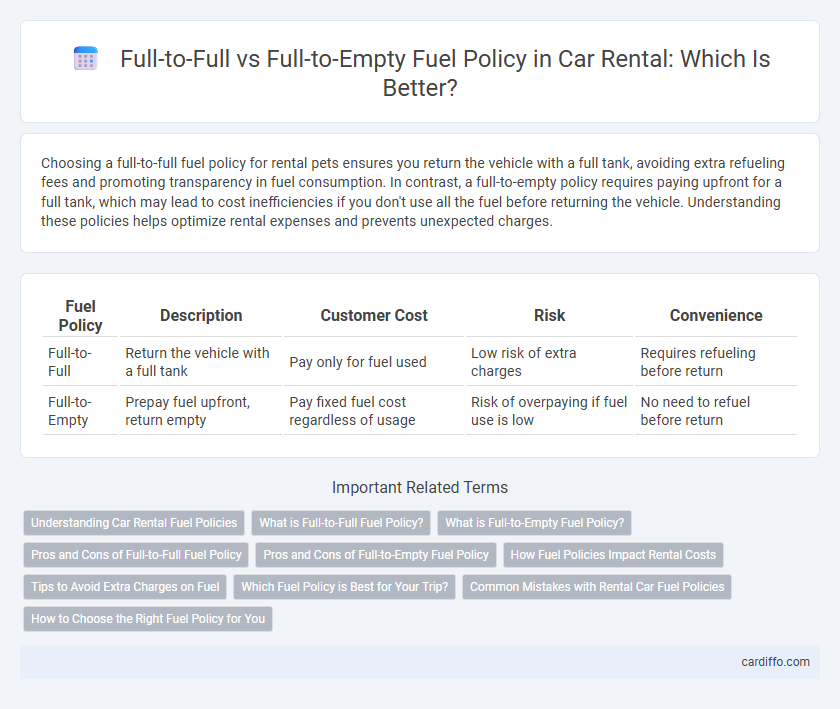Choosing a full-to-full fuel policy for rental pets ensures you return the vehicle with a full tank, avoiding extra refueling fees and promoting transparency in fuel consumption. In contrast, a full-to-empty policy requires paying upfront for a full tank, which may lead to cost inefficiencies if you don't use all the fuel before returning the vehicle. Understanding these policies helps optimize rental expenses and prevents unexpected charges.
Table of Comparison
| Fuel Policy | Description | Customer Cost | Risk | Convenience |
|---|---|---|---|---|
| Full-to-Full | Return the vehicle with a full tank | Pay only for fuel used | Low risk of extra charges | Requires refueling before return |
| Full-to-Empty | Prepay fuel upfront, return empty | Pay fixed fuel cost regardless of usage | Risk of overpaying if fuel use is low | No need to refuel before return |
Understanding Car Rental Fuel Policies
Understanding car rental fuel policies is crucial for cost-effective vehicle use, with full-to-full and full-to-empty being the most common types. Full-to-full requires returning the car with a full tank, often avoiding extra refueling charges, while full-to-empty involves paying upfront for a full tank and returning the car empty or near empty, sometimes leading to higher fuel costs. Awareness of these policies helps renters optimize fuel expenses and avoid unexpected fees during car rental periods.
What is Full-to-Full Fuel Policy?
Full-to-full fuel policy requires renters to return the vehicle with a full tank of fuel, matching the level at pickup to avoid refueling charges. This approach offers transparency and cost savings by allowing customers to refuel at preferred gas stations and prices. Rental companies benefit from reduced administrative fees and fuel surcharges compared to full-to-empty policies.
What is Full-to-Empty Fuel Policy?
Full-to-empty fuel policy requires renters to return the vehicle with an empty fuel tank, allowing them to use the entire amount of fuel purchased at the start without refueling before return. This policy often provides convenience for users who plan long trips without the need to find a fuel station near the drop-off location. However, it may result in higher overall fuel costs compared to full-to-full policies, as renters pay upfront for a full tank regardless of actual fuel consumption.
Pros and Cons of Full-to-Full Fuel Policy
The full-to-full fuel policy requires renters to return the vehicle with a full tank, minimizing extra fuel charges and encouraging efficient fuel use. This approach provides transparency and potential cost savings compared to full-to-empty options, which may include inflated refueling fees. However, renters must remember to refill before returning, or risk being charged high fuel prices by the rental company.
Pros and Cons of Full-to-Empty Fuel Policy
The Full-to-Empty fuel policy requires renters to return the vehicle with an empty tank, often allowing them to pay upfront for a full tank at a fixed rate, which can be convenient for short trips or when refueling stations are scarce. However, this policy may result in customers overpaying for unused fuel if they don't fully deplete the tank, increasing rental costs. The Full-to-Empty system also removes the responsibility of refueling from renters, but it can encourage wastefulness and reduce transparency in fuel charges compared to Full-to-Full policies.
How Fuel Policies Impact Rental Costs
Fuel policies significantly influence rental costs by determining how much fuel renters must pay upfront and upon return. Full-to-full policies require renters to return the vehicle with a full tank, avoiding extra charges, while full-to-empty policies often charge inflated rates for refueling, increasing overall expenses. Understanding these policies helps renters optimize fuel expenses and choose more cost-effective rental options.
Tips to Avoid Extra Charges on Fuel
Choose a full-to-full fuel policy to minimize unexpected refueling fees by returning the vehicle with a full tank, ensuring you are only charged for the exact fuel used. Keep the receipt if you refuel yourself, and plan refueling stops before returning the car to avoid pay-per-gallon surcharges common in full-to-empty agreements. Use GPS or mobile apps to locate the nearest fuel stations to the rental return location, preventing last-minute refueling at expensive airport pumps.
Which Fuel Policy is Best for Your Trip?
Choosing the best fuel policy for your rental depends on your travel plans and convenience preferences. Full-to-full requires you to return the vehicle with a full tank, often saving money as you only pay for the fuel you use. Full-to-empty offers flexibility by allowing you to return the car empty, but it usually involves higher costs due to prepayment at rental rates.
Common Mistakes with Rental Car Fuel Policies
Common mistakes with rental car fuel policies include misunderstanding the full-to-full requirement, where renters must return the vehicle with a full tank to avoid refueling charges, versus full-to-empty, which allows using the fuel without refilling but often leads to higher fees. Renters frequently overlook inspecting the fuel gauge at pickup, resulting in unexpected costs when the tank is not truly full. Careful attention to the specific fuel policy stated in the rental agreement helps avoid unnecessary fuel charges and disputes.
How to Choose the Right Fuel Policy for You
Choosing the right fuel policy for your rental car depends on your driving habits and budget. Full-to-full fuel policies often save money by requiring you to return the vehicle with a full tank, avoiding extra refueling charges, while full-to-empty options offer convenience by allowing you to return the car with any fuel level at a fixed price. Assess your expected mileage and local fuel prices to determine whether the cost savings of a full-to-full policy outweigh the convenience of a full-to-empty agreement.
Fuel policy: Full-to-full vs Full-to-empty Infographic

 cardiffo.com
cardiffo.com